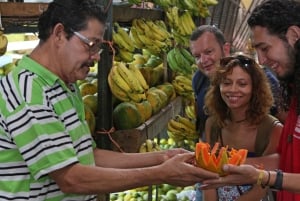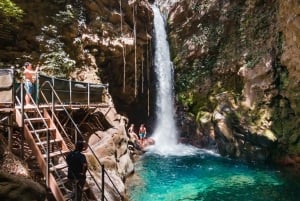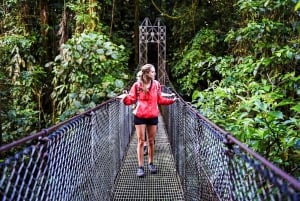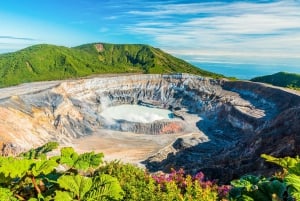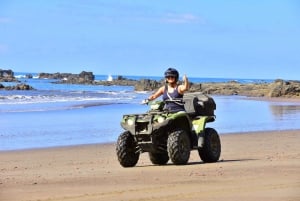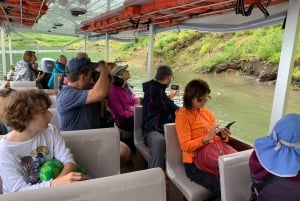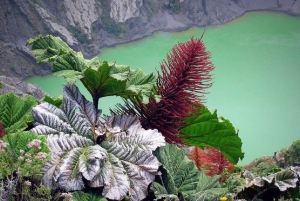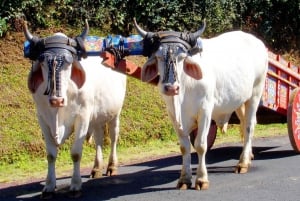Puntarenas Province
Puntarenas Province is the largest of all provinces of Costa Rica with the majority lying along the Pacific coast. It's northern border includes a portion of the NIcoya Peninsula Region at Punta Flor, in the Isle of Chira, and the entire South Pacific Region to the border including Cano Island, located offshore near the Gulf of Golfito. It's eastern boundary cascades along the Tilaran and Talamanca mountain range with valleys and ridges descending all the way to the shoreline of the Pacific. Puntarenas Province is also one of the least traveled in it's southern regions as it was not connected entirely to the Inter American Highway past the city of Quepos until recently. This kept many travelers from venturing into the area with the exception of surfers and fishermen, braving the many river crossings and pot hole roads that existed to explore an area less traveled. The more familiar districts of the northern regions like Monteverde, Jaco and Manuel Antonio, where the highways were completed many years ago, have already become well known to the tourist and weekend city dwellers seeking the perfect beach paradise as well as the many beautiful sights this province holds.
The city of Puntarenas is the capital of the province and located on the shores of the Pacific at the east side of the Gulf of Nicoya. Puntarenas has long been a favorite of the locals for the beaches, fishing and lively local fare found there. On weekends and holidays the beaches are filled and the streets swollen with traffic that converges on it from the central valley and the city populations. In the past Puntarenas was an important shipping port for the Pacific cargo coming in and out of Costa Rica but is primarily used today for the cruise ships that visit it's port. The majority of shipping has moved to the port at Caldera, south of Puntarenas but the harbor is still dotted with the fishing boats of the locals that supply fresh seafood daily to the local restaurants. Puntarenas and the surrounding towns in the north offer a wide variety of attractions, restaurants, accommodations and tours so any visitor to this area will find it easy to fill their days.
Parts of the Nicoya Peninsula Region lie in this province holding some great sights north of the capital such as Monteverde Cloud Forest Reserve, Chira Island, San Lucas Island, Santa Elana Reserve and Tambor. The combinations of gulf waters, Pacific Ocean, mountain ranges, fauna and flora make for a wonderful destination in this part of Puntarenas Province.
Traveling south of Puntarenas you can venture into the towns (districts) of Jaco, Playa Hermosa, and Herradura finding a variety of top notch resorts to tiny cabina's for those on a budget. Jaco is a thriving tourist town and one of the most popular on the Pacific coast. Many locals have made their homes in this area to live off the tourism that flocks here but you will also find evidence of business owners from around the world that visited in earlier years and came back to make it their home. The main street of Jaco is filled with restaurants, clothing stores, markets, bars and a variety of other businesses attracting both locals and tourist to venture down the busy road. There is not a lack of choices for nightlife in this area which may be the very reason it attracts so many in contrast to the sleepy, quaint towns further south. Whatever the reason, the area has a lot to offer aside from beaches with waterfall tours, horseback riding, and a variety of other activities. It is convenient to several National Parks, Wildlife Reserves and Biological Centers giving the visitor a wide source to choose from in this area of Punterenas Province.
Continuing further into the South Pacific Region on the Inter American Highway, the next area well known is that of Quepos and Manuel Antonio situated next to one another. Quepos has a well known marina that has long been a favorite for the fisherman visiting Costa Rica. The lure of some of the best fishing in the world keeps it's port busy with fishing charters as well as the local fishermen that have supplied the fresh seafood for the area for generations. The town offers an airport with direct flights daily to and from San Jose and Liberia for those travelers not wishing to make the journey by car. It's town square holds the major market, bus terminal and local government offices surrounded by bstling streets of businesses that one can find almost anything needed. Some of the better hotels and restaurants are located on the main road to Manuel Antonio along with art galleries, furniture shops and souvenir markets.
Winding your way through Quepos you will find the road that leads to Manuel Antonio, probably the most visited sight in the area, well known for it's pristine beaches, luxurious resorts and National Park. There are actually many visitors that do not find the need to leave Manuel Antonio once they arrive, mesmerized by the beautiful sunsets, relaxing atmosphere and great food. Wow is the word most uttered as you come over the winding road into Manuel Antonio and get the first glimpses of how beautiful it is. Manuel Antonio National Park is a great way to spend the day with family or friends traveling with you, enjoy a sun filled day at the beach and lounge at some of the beachside restaurants afterwards to watch the amazing sunset. Your choices of activities are unlimited so sit back and enjoy the view.
Forty five minutes south of Quepos you will run into the small towns of Dominical, Uvita and Ojochal all sitting along the Pacific shoreline. Dominical is a surfers paradise with inexpensive accommodations, great waves, good food and music venues. There are a variety of upscale hotels for those with a different preference but most of them are located outside of the town in the mountains east of the Inter American Highway. Uvita is the main stopping point for gas, groceries and banking for 30 miles and is one of the fastest growig districts in the region. Unlike Dominical, Uvita & Ojochal have more permeant residents surrounding the town and very seldom get the influx of tourist that Dominical seems to attract. Both have great restaurants, a wide variety of accommodations, waterfall tours and loads of other activities offered. You can find the fabulous Marino Ballena National Park entrance in Uvita.
From Dominical, if you leave the coast, you can go inland for forty five minutes to reach the largest city in the area, San Isidro. It provides the primary commerce, hospitals and government offices for the southern part of the province and is a main source for employment in this part of the country. It is a thriving town with busy streets, sidewalk cafes, markets and the closest place for the Pacific coast to purchase major products and automobiles. It is also the main hub of transportation to and from San Jose. There are some quaint districts surrounding San Isidro in the valley and to the north that are well worth visits on your way to sights such as Chirripo National Park and numerous waterfalls that are major attractions. Find accommodations for San Isidro by checking our accommodations tab.
South of Ojochal and beyond you will start entering areas that time has forgotten. The Osa Peninsula and Drake Bay are one of the most diversified eco systems in left in the country hosting endangered species of both flora and fauna. Known as the "Jewel" of the South Pacific, it is one of the most desirable eco tourist destinations in Costa Rica. Large tracks of land have been laid aside by the government to preserve this natural landscape in hopes of protecting it from illegal mining of river rock and timber as well as hunting. Corcovado National Park is one of these protected areas and is an amazing piece of nature drawing the simple nature lovers from around the world. It remains the single largest stretch of tropical lowlands left in Central America with dense forest, miles of pristine beaches and numerous trails that allow the visitor to get up close to it's remarkable beauty. Accommodations in this area are primarily eco-friendly lodges, quaint establishments with small local restaurants scattered along the main highway.
The southern most tip of Puntarenas Province ends around the Panamanian border near the town of Golfito. The small town sits on the shores of the Dulce de Golfito and has it's share of travelers as the last town before the border. It is a quaint beach town surrounded by the amazing forest that make up the beauty of the rest of the Osa Peninsula. There may not be much nightlife offered down this way but the scenery certainly makes up for what it lacks in this area. Hiking, rafting, canopy tours, sport fishing, scuba and surfing are the daytime choices with relaxing afternoons snoozing in a hammock somewhere off the beaten path or spending the day on one of the endless beaches on the Gulf. Accommodations range from Eco Lodges, upscale to beachside cabins.
Main Attractions / Towns in Puntarenas Province
| Cabo Matapalo | Carara Nature Reserve | Carate |
| Corcovado National Park | Chirripo National Park | Dominical |
| Drake Bay | Herradura | Esterillos |
| Manuel Antonio | Manuel Antonio National Park | Marino Ballena National Park |
| Monteverde Cloud Forest | Ojochal | Palmar |
| Parrita | Playa Jaco | Puerto Jimenez |
| Puntarenas | Quepos | Uvita |
| Zancudo |
While Puntarenas Province has remarkable diversity from one end to the other, the visitor will come away amazed at the sights as well as the simplicity it holds within the reaches of the nature around it. Take time to review the accommodations, restaurants and tour services offered on our web sight to ensure that you are getting that perfect setting you seek while traveling the amazing sights in this province.









